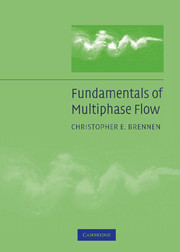Book contents
- Frontmatter
- Contents
- Preface
- Nomenclature
- 1 Introduction to Multiphase Flow
- 2 Single-Particle Motion
- 3 Bubble or Droplet Translation
- 4 Bubble Growth and Collapse
- 5 Cavitation
- 6 Boiling and Condensation
- 7 Flow Patterns
- 8 Internal Flow Energy Conversion
- 9 Homogeneous Flows
- 10 Flows with Bubble Dynamics
- 11 Flows with Gas Dynamics
- 12 Sprays
- 13 Granular Flows
- 14 Drift Flux Models
- 15 System Instabilities
- 16 Kinematic Waves
- Bibliography
- Index
8 - Internal Flow Energy Conversion
Published online by Cambridge University Press: 05 June 2014
- Frontmatter
- Contents
- Preface
- Nomenclature
- 1 Introduction to Multiphase Flow
- 2 Single-Particle Motion
- 3 Bubble or Droplet Translation
- 4 Bubble Growth and Collapse
- 5 Cavitation
- 6 Boiling and Condensation
- 7 Flow Patterns
- 8 Internal Flow Energy Conversion
- 9 Homogeneous Flows
- 10 Flows with Bubble Dynamics
- 11 Flows with Gas Dynamics
- 12 Sprays
- 13 Granular Flows
- 14 Drift Flux Models
- 15 System Instabilities
- 16 Kinematic Waves
- Bibliography
- Index
Summary
Introduction
One of the most common requirements of a multiphase flow analysis is the prediction of the energy gains and losses as the flow proceeds through the pipes, valves, pumps, and other components that make up an internal flow system. In this chapter we attempt to provide a few insights into the physical processes that influence these energy conversion processes in a multiphase flow. The literature contains a plethora of engineering correlations for pipe friction and some data for other components such as pumps. This chapter provides an overview and some references to illustrative material but does not pretend to survey these empirical methodologies.
As might be expected, frictional losses in straight uniform pipe flows have been the most widely studied of these energy conversion processes and so we begin with a discussion of that subject, focusing first on disperse or nearly disperse flows and then on separated flows. In the last part of the chapter, we consider multiphase flows in pumps, in part because of the ubiquity of these devices and in part because they provide a second example of the multiphase flow effects in internal flows.
Frictional Loss in Disperse Flow
Horizontal Flow
We begin with a discussion of disperse horizontal flow. There exists a substantial body of data relating to the frictional losses or pressure gradient, (−dp/ds), in a straight pipe of circular cross section (the coordinate s is measured along the axis of the pipe).
Information
- Type
- Chapter
- Information
- Fundamentals of Multiphase Flow , pp. 155 - 175Publisher: Cambridge University PressPrint publication year: 2005
